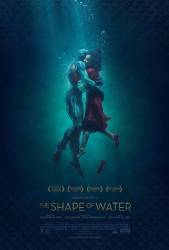Corrected entry: Security cameras were not used in U.S. Government buildings before the 1970's.
Corrected entry: In the early scenes Elisa has marks on the right side of her neck. In the final scene the marks have moved to the left side of her neck.
Correction: She has those marks on both sides of her neck from the beginning, which are revealed to be gills at the end of the film, which also possibly accounts for her muteness.
Corrected entry: Michael Shannon is interrogating the custodial staff Octavia Spencer and Elisa Esposito in his office regarding the missing amphibian man. He makes a very rude snide nasty comment saying "I don't know why I am asking the help." This is a reference to Octavia Spencer's role as a maid in the movie The Help.
Correction: Or he's just saying "the help" because that's what they are. Far too tenuous a connection.
Corrected entry: General Hoyt is shown as a five star General, and he makes reference to it. However, this rank did not exist in 1962. The last person to hold this rank was Omar Bradley in 1950.
Correction: The rank of General of the Army (5-Star general) still exists, it's simply that no one has been given that rank since General Bradley. But as a fictitious character, there is nothing wrong with General Hoyt obtaining the rank simply because no one else has. Though some may say the rank was retired in the 80's after Bradley's death, there have been a few who were considered for the rank in modern times, such as Powell and Schwarzkopf.
Corrected entry: In the film it is advised that the creature be maintained at 5 - 8% salinity. The sea is only around 3.5%. It seems odd that he should need so much salt.
Correction: The film states he's not from the ocean. He's from a specific, presumably fictional, area of the Amazon where he was worshiped as a god. We can simply assume the area has water with a higher salinity level than ocean water. (As there are places around the world that have water with significantly higher salinity levels than ocean water).
Those bodies of water on the earth's surface with much higher salt content are invariably isolated lakes and inland seas that were formerly connected to the oceans in the distant past. Such high-salt lakes are the result of many millennia (even millions of years) of evaporation and reduction, which results in the nearby terrain becoming almost devoid of vegetation (due to the increasingly high alkalinity of the surrounding water table). So, you would expect to see near-desert-like conditions in the vicinity of isolated salt lakes and inland seas and virtually no large wildlife (except maybe migrating flamingos at certain times of the year). Point is, while there is evidence of "marine incursion" across the northern half of South America as far back as 14 million years ago (which did, in fact, produce the largest salt flats in the world at Uyuni, Bolivia), these salt lakes are very hostile and even toxic to complex life. Large animals, such as gill-people, simply couldn't have evolved there, with a saline content more than twice that of the ocean and virtually no food chain.
He's meant to be a river god, as confirmed by the director, who wrote: "It is a river God. It's not an animal. It's a river God in the Amazon. There was never another one." Therefore, it's entirely possible he survived in such a harsh environment and thrived.






Correction: This is a highly advanced (and fictional) research facility.